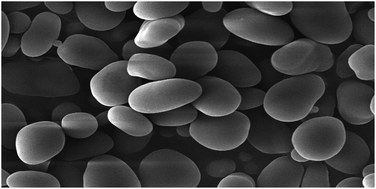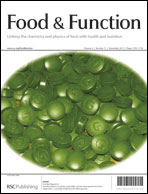The in vitro effects of retrograded starch (resistant starch type 3) from lotus seed starch on the proliferation of Bifidobacterium adolescentis
Abstract
Prebiotics such as oligosaccharides, fructans, and resistant starch (RS) stimulate the growth of beneficial bacteria in large bowel and modify the human gastrointestinal environment. In this study, compared with glucose (GLU) and high amylose maize starch (HAMS), the in vitro effects of LRS3 and P-LRS3 (RS3 and purified RS3 prepared from lotus seed starch) on the proliferation of bifidobacteria were assessed by assessing the changes in optical density (OD), pH values, short chain fatty acid (SCFA) production, and tolerance ability to gastrointestinal conditions. Significantly higher OD values were obtained from media containing LRS3 and P-LRS3, and especially in the medium containing P-LRS3, the OD value of which reached 1.36 when the concentration of the carbon source was 20 g L−1. Additionally, the lag phase of bifidobacteria was 8 h in the medium with LRS3 or P-LRS3, whereas it was 16 h in the medium with GLU or HAMS. What is more, a higher content of butyric acid was obtained in the P-LRS3 medium. Compared with GLU and HAMS media, bifidobacteria had a higher tolerance to gastrointestinal conditions in LRS3 and P-LRS3 media. It shows that lotus seed resistant starch, especially P-LRS3, could stimulate the growth of bifidobacteria. The rough surface of resistant starch and the SCFAs produced during fermentation might influence the proliferation of bifidobacteria.


 Please wait while we load your content...
Please wait while we load your content...